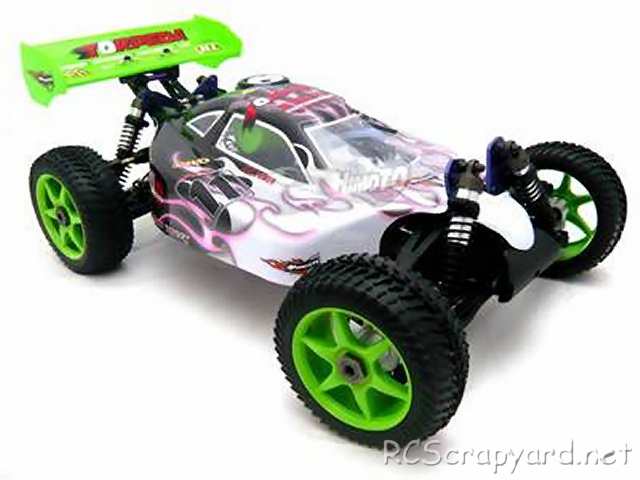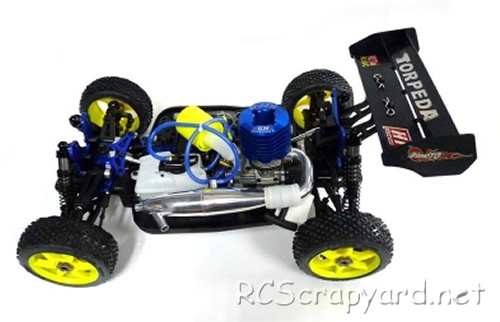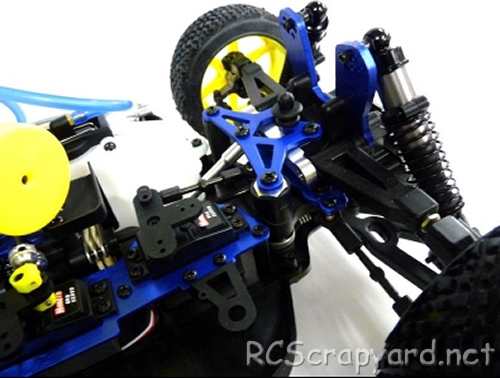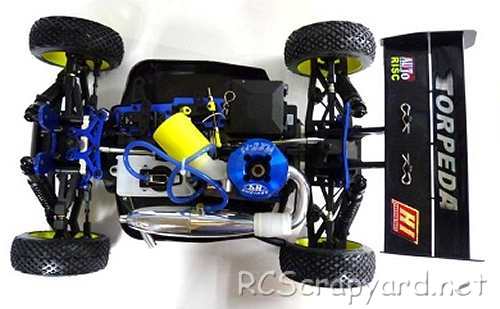

|
|
|


|
|
1/8 Scale Nitro Buggy:
Himoto Torpeda Pro - # HI8202
|
Introduced by Himoto Racing circa 2005, the 4WD Torpeda Pro Buggy - # HI8202 - came with a 4.6cc engine, radio system and a number of bodyshell options. An Electric Starter version was also available - # HI8202E.
The model is shaft driven, on an alloy plate chassis, with gear type differentials, coil spring over oil filled dampers, rear dogbones, with front universal joint drive-shafts and ball bearings.
A Torpeda Pro Upgrade version - # HI8202M - was released in 2007, with a wide number of upgrade alloy parts installed.
This model was made for Himoto by HSP Racing based on their Bazooka Buggy.

To race the Himoto Torpeda Pro, it needs to be tuned to perfection for better stability, precise steering and provide enough grip to keep you on the track when going around tight bends at high speed. Even the smallest adjustment can change the feel of a car and our simple to follow instructions will guide you to the best Set-up to get you to the front and keep you there.








|
|
|

★ Himoto Torpeda Pro ★

★ Himoto Torpeda Pro Chassis ★

★ Himoto Torpeda Pro Chassis ★

|
Buying a Used Himoto Torpeda Pro Buggy (and What to look for)
Make a General Visual Inspection
Check the Body-Shell
If the body shell of your Himoto Torpeda Pro is broken, ripped or damaged in any way, this can be easily repaired with rubber solution glue. Also, for added protection and if available for your Torpeda Pro model, fit an under guard to stop dirt and gravel entering the chassis. Drive Shafts and Turnbuckles
Examine the Drive System
The gearbox of your used Buggy should be opened up to check for gear wear and lubrication. A thin coat of grease is often used on internal gears and although this is fine for basic running around on the back yard, if you intend to race your Buggy at a higher level, this should be removed and replaced with racing oil (ZX1 or Teflon Oil). Of course, this should be reapplied after each race meeting. Pinions and Spur Gears
Don't Neglect the Ball-Joints
Ball joints always cause problems. For top level Nitro Buggy racing, the plastic ball connectors should be checked and if deemed necessary changed after every meeting. A simple thing like a loose fitting connector popping off could easily end your race, so better safe than sorry. Steering Servo and Servo-Saver
Stabilizers
If body roll on your Himoto Torpeda Pro is a problem, handling can be improved with the use of stabilizers, anti roll or sway bars, stiffer tuning springs and, or, thicker silicone oil in the dampers. Don't Forget those Bearings
▼ Scroll Down for More Articles and Advice ▼
Or, check out our RC Model Car Setup Guide
|
|
Manufacturers and Brands Catalogued, Listed and Reviewed by RC-Scrapyard.
At present, the RC Model Manufacturers, Brands and Distributors covered by us are: ABC Hobby, Academy, Acme Racing, Agama Racing, Amewi, Ansmann Racing, ARRMA, Team Associated, Atomic RC, Axial, AYK, Bolink, BSD Racing, Capricorn, Carisma, Carson, Caster Racing, Cen, Corally, Custom Works, Durango, Duratrax, ECX - Electrix, Exceed RC, FG Modellsport, FS-Racing, FTX, Fujimi, Gmade, GS-Racing, Harm, HBX, Helion, Heng Long, Himoto Racing, Hirobo, Hitari, Hobao, Hong-Nor, Hot Bodies, HPI, HSP, Intech, Integy, Jamara, JQ Products, Kawada, Kyosho, Losi, LRP, Maisto, Mardave, Marui, Maverick, MCD Racing, Megatech, Mugen, New Bright, Nichimo, Nikko, Nkok, Ofna, Pro-Pulse, Protech, PTI, RC4WD, Redcat Racing, RJ-Speed, Robitronic, Schumacher, Seben, Serpent, Smartech, Sportwerks, Step-Up, Tamiya, Team-C Racing, Team Magic, Thunder Tiger, Tomy, Top Racing, Traxxas, Trinity, Tyco, Vaterra RC, Venom, VRX Racing, WLToys, X-Factory, Xmods, Xpress, Xray, XTM, Yankee RC, Yokomo, ZD Racing and Zipzaps. |
|
Hints, Tips and Information
Dampers
Dampers, Shock Absorbers, Shocks - call them what you will, they are one of the least understood, but most important tools you have for adjusting the handling characteristics of your RC model.
So how do Dampers work?
Basically what you have is a small amount of silicone oil contained in a sealed cylinder. Through the centre of that cylinder is a metal rod, and on the end of that rod, a piston with a number of small holes in it. Pulling, or pushing the rod in and out of the cylinder, your will notice a certain amount of resistance as the oil is forced through the holes in the piston. |
|
Hints, Tips and Information
Anti Squat
Described as the angle at which the suspension arms pivot in relation to the chassis, Anti Squat affects traction under acceleration. |
|
RC Models:
|
Radio & Motors: |
Other
Accessories: |